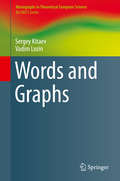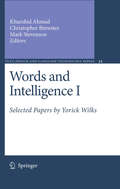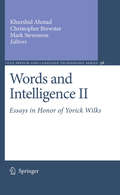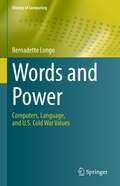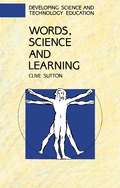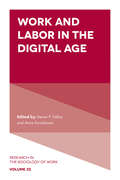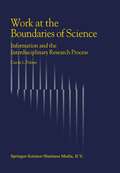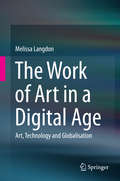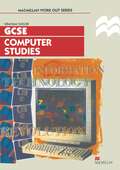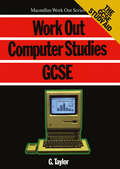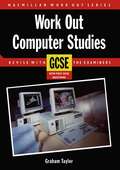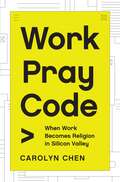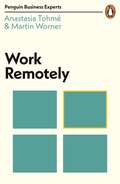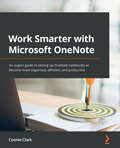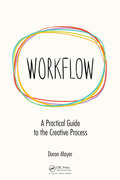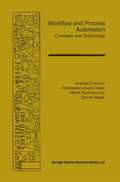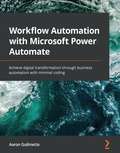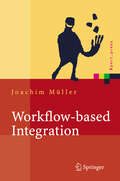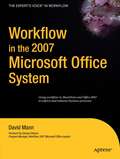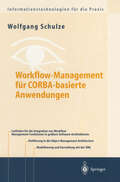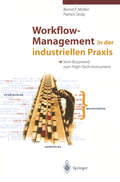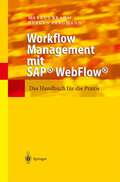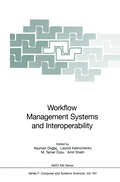- Table View
- List View
Words and Graphs (Monographs in Theoretical Computer Science. An EATCS Series)
by Sergey Kitaev Vadim LozinThis is the first comprehensive introduction to the theory of word-representable graphs, a generalization of several classical classes of graphs, and a new topic in discrete mathematics.After extensive introductory chapters that explain the context and consolidate the state of the art in this field, including a chapter on hereditary classes of graphs, the authors suggest a variety of problems and directions for further research, and they discuss interrelations of words and graphs in the literature by means other than word-representability.The book is self-contained, and is suitable for both reference and learning, with many chapters containing exercises and solutions to seleced problems. It will be valuable for researchers and graduate and advanced undergraduate students in discrete mathematics and theoretical computer science, in particular those engaged with graph theory and combinatorics, and also for specialists in algebra.
Words and Intelligence I: Selected Papers by Yorick Wilks (Text, Speech and Language Technology #35)
by Khurshid Ahmad Christopher Brewster Mark StevensonThis book celebrates the work of Yorick Wilks in the form of a selection of his papers which are intended to reflect the range and depth of his work. The volume accompanies a Festschrift which celebrates his contribution to the fields of Computational Linguistics and Artificial Intelligence. The selected papers reflect Yorick’s contribution to both practical and theoretical aspects of automatic language processing.
Words and Intelligence II: Essays in Honor of Yorick Wilks (Text, Speech and Language Technology #36)
by Khurshid Ahmad Christopher Brewster Mark StevensonYorick Wilks is a central figure in the fields of Natural Language Processing and Artificial Intelligence. This book celebrates Wilks’s career from the perspective of his peers in original chapters each of which analyses an aspect of his work and links it to current thinking in that area. This volume forms a two-part set together with Words and Intelligence I: Selected Works by Yorick Wilks, by the same editors.
Words and Power: Computers, Language, and U.S. Cold War Values (History of Computing)
by Bernadette LongoWhen viewed through a political lens, the act of defining terms in natural language arguably transforms knowledge into values. This unique volume explores how corporate, military, academic, and professional values shaped efforts to define computer terminology and establish an information engineering profession as a precursor to what would become computer science. As the Cold War heated up, U.S. federal agencies increasingly funded university researchers and labs to develop technologies, like the computer, that would ensure that the U.S. maintained economic prosperity and military dominance over the Soviet Union. At the same time, private corporations saw opportunities for partnering with university labs and military agencies to generate profits as they strengthened their business positions in civilian sectors. They needed a common vocabulary and principles of streamlined communication to underpin the technology development that would ensure national prosperity and military dominance. investigates how language standardization contributed to the professionalization of computer science as separate from mathematics, electrical engineering, and physicsexamines traditions of language standardization in earlier eras of rapid technology development around electricity and radiohighlights the importance of the analogy of “the computer is like a human” to early explanations of computer design and logictraces design and development of electronic computers within political and economic contextsforegrounds the importance of human relationships in decisions about computer designThis in-depth humanistic study argues for the importance of natural language in shaping what people come to think of as possible and impossible relationships between computers and humans. The work is a key reference in the history of technology and serves as a source textbook on the human-level history of computing. In addition, it addresses those with interests in sociolinguistic questions around technology studies, as well as technology development at the nexus of politics, business, and human relations.
Words, Science and Learning (UK Higher Education OUP Humanities & Social Sciences Education OUP)
by Clive SuttonDespite the power of words to move minds, appreciating the written or spoken word is rarely thought to be the essence of teaching and learning science and much more effort goes into organizing practical work. There is an exaggerated confidence in the value of the direct experience of things as opposed to "mere words", and a corresponding neglect of how words are actually involved in developing anyone's scientific understanding. Clive Sutton does not wish to deny the value of first hand scientific understanding, and shows that they cannot just be taken for granted while we busy ourselves in the organization of practical work. He explores the role of language in the growth of science itself, in the growth of learners' ideas, and in classroom practice; and how these relate, for instance, to some pupils' alienation from science and the isolation of science in the curriculum.
Work and Labor in the Digital Age (Research in the Sociology of Work #33)
by Steven P. Vallas Anne KovalainenThis volume presents the most recent studies of work and labor in the digital age as it unfolds in both Europe and the United States. One of the critical questions facing modernity concerns the reconfiguration of paid employment, which has been subject to wholesale changes that have widespread consequences for workers, their families, and the institutional structure that characterizes capitalist societies. A key driver of these changes has been the digital revolution and the rapid proliferation of the gig economy. Together with social network sites for hiring, the spread of robotics, and the rise of artificial intelligence and machine learning, they leave virtually no occupation untouched.
Work and Labor in the Digital Age (Research in the Sociology of Work #33)
by Steven P. Vallas Anne KovalainenThis volume presents the most recent studies of work and labor in the digital age as it unfolds in both Europe and the United States. One of the critical questions facing modernity concerns the reconfiguration of paid employment, which has been subject to wholesale changes that have widespread consequences for workers, their families, and the institutional structure that characterizes capitalist societies. A key driver of these changes has been the digital revolution and the rapid proliferation of the gig economy. Together with social network sites for hiring, the spread of robotics, and the rise of artificial intelligence and machine learning, they leave virtually no occupation untouched.
Work at the Boundaries of Science: Information and the Interdisciplinary Research Process
by C.L. PalmerInterdisciplinary inquiry has become more pervasive in recent decades, yet we still know little about the conduct of this type of research or the information problems associated with it. This book is one of few empirical studies of interdisciplinary knowledge practices. It examines how interdisciplinary scientists discover and exchange information and knowledge, highlighting how the boundaries between disciplines affect how information is used and how knowledge is constructed. It is written for scholars and practitioners with an interest in developing information systems and research environments to foster innovative scientific work. Target groups include researchers in information science, science studies, communication, as well as research administrators and information professionals.
The Work of Art in a Digital Age: Art, Technology And Globalisation
by Melissa LangdonThis book explores digital artists’ articulations of globalization. Digital artworks from around the world are examined in terms of how they both express and simulate globalization’s impacts through immersive, participatory and interactive technologies. The author highlights some of the problems with macro and categorical approaches to the study of globalization and presents new ways of seeing the phenomenon as a series of processes and flows that are individually experienced and expressed. Instead of providing a macro analysis of large-scale political and economic processes, the book offers imaginative new ways of knowing and understanding globalization as a series of micro affects. Digital art is explored in terms of how it re-centers articulations of globalization around individual experiences and offers new ways of accessing a complex topic often expressed in general and intangible terms. The Work of Art in a Digital Age: Art, Technology and Globalization is analytic and accessible, with material that is of interest to a range of researchers from different disciplines. Students studying digital art, film, globalization, cultural studies or digital media trends will also find the content fascinating.
Work Out Computer Studies GCSE (Macmillan Work Out)
by Graham TaylorWork Out Computer Studies GCSE focusses on the essential computer studies you need to get the grade you want. The book gives you: * advice on the course, study and exam technique * knowledge - full notes of what you need to know, with model answers giving explanations on technique * practice - more GCSE questions to build skills and understanding, with answers * confidence - from our Self Check pages you can see how you are doing and where the extra work is needed
Work Out Computer Studies GCSE (Macmillan Work Out)
by Graham TaylorPart of a series designed to give intensive instruction for GCSE exams. This book contains, aside from the basic text, advice on revision and exam technique and self-test sections.
Work Pray Code: When Work Becomes Religion in Silicon Valley
by Carolyn ChenHow tech giants are reshaping spirituality to serve their religion of peak productivitySilicon Valley is known for its lavish perks, intense work culture, and spiritual gurus. Work Pray Code explores how tech companies are bringing religion into the workplace in ways that are replacing traditional places of worship, blurring the line between work and religion and transforming the very nature of spiritual experience in modern life.Over the past forty years, highly skilled workers have been devoting more time and energy to their jobs than ever before. They are also leaving churches, synagogues, and temples in droves—but they have not abandoned religion. Carolyn Chen spent more than five years in Silicon Valley, conducting a wealth of in-depth interviews and gaining unprecedented access to the best and brightest of the tech world. The result is a penetrating account of how work now satisfies workers’ needs for belonging, identity, purpose, and transcendence that religion once met. Chen argues that tech firms are offering spiritual care such as Buddhist-inspired mindfulness practices to make their employees more productive, but that our religious traditions, communities, and public sphere are paying the price.We all want our jobs to be meaningful and fulfilling. Work Pray Code reveals what can happen when work becomes religion, and when the workplace becomes the institution that shapes our souls.
Work Remotely (Penguin Business Experts Series #9)
by Martin Worner Anastasia TohméRemote working makes us happier, more productive and more profitable, but it can bring its own set of challenges. How do we manage our work-life balance; communicate and collaborate effectively as teams; and ensure our technology is efficient?In Work Remotely, Penguin Business Experts Anastasia Tohmé and Martin Worner explain everything you need to know:- Set your own targets and monitor productivity- Establish boundaries between working hours and free time- Manage effective communication and decision-making at a distanceIncluding case studies from the companies around the world who are innovating and revolutionizing the way we work, Work Remotely shares useful advice and practical tips to ensure you get the most out of working away from the office environment.
Work Smarter with Microsoft OneNote: An expert guide to setting up OneNote notebooks to become more organized, efficient, and productive
by Connie ClarkOrganize work and home life using notes from your phone or computer to supercharge your productivity with this OneNote manualKey FeaturesLearn how to store notes that include images, audio, videos, links, files, emails, and web clippingsUnleash the magic of tags to make notes stand out and become more searchableDiscover the power of shared notebooks with your team or family to ensure everyone is in the loopBook DescriptionDo you want to take your information and note organization to a new level? This book will show you how to use Microsoft's organizational app, OneNote, to store endless amounts of information in a productive and organized way, including solutions for creating your notes and then sharing them easily with your team or department.You'll be guided through everything you need to set up a notebook and customize it to suit you or your team. The book will show you how to navigate through OneNote and search for virtually anything, as well as save time with all the shortcuts. You'll discover that inserting information into your notebooks goes far beyond text, images, and videos, and also includes emails, links to documents, and clippings from the web. But it doesn't stop there. Integration with other Microsoft products is key for making your experience successful, and this book demonstrates how to use OneNote with Microsoft Outlook, OneDrive, SharePoint and Teams. Beyond instructions and essential topics, this book also provides you with the motivation you need to make OneNote a habit as well as real-life examples of notebooks you can use.By the end of this book, you'll be able to use OneNote for everything and from every device. Even if you start a notebook on your laptop and continue it on your phone, you'll find working with the app seamless.What you will learnUnderstand how to create and organize notes in your notebooksDiscover how to turn handwritten notes into typed textExplore how to access your content from anywhere even if offlineUncover ways to collaborate with your team or family and stay in syncUnderstand how to insert your emails, documents, or articles from the webFind out how to integrate with other Microsoft products such as Outlook or TeamsWho this book is forIf you save notes on your phone, wear out more spiral notebooks than you can count, or if you're a Microsoft 365 user and need to keep track of information, then this book is for you. Beginner-level experience with OneNote is required to get the most out of this book.
Workflow: A Practical Guide to the Creative Process
by Doron MeirA pro isn’t just a person who can do it well. It’s a person who can do it well every time, on demand and on deadline; which is why the key to being a professional creative is having a great creative process. Whether it’s writing a book, animating a shot, designing a game level or composing a soundtrack—ultimately, we’re all facing similar challenges. Since we share challenges, we can also share solutions. This book is a practical guide, featuring a universal creative process that can streamline any serious creative work, on any scale. Key Features Universal approach: applies to any process that starts with an idea and ends with a refined product. Profound and light: combines conceptual ideas with practical tips and fun anecdotes. Caricatures and samples: helps visually clarify ideas and processes. Variety of creative fields: draws on examples from writing, animation, game design, 3D modeling, music, sculpting and more Printable summaries: provides visual outlines that can be used as cheat-sheets.
Workflow: A Practical Guide to the Creative Process
by Doron MeirA pro isn’t just a person who can do it well. It’s a person who can do it well every time, on demand and on deadline; which is why the key to being a professional creative is having a great creative process. Whether it’s writing a book, animating a shot, designing a game level or composing a soundtrack—ultimately, we’re all facing similar challenges. Since we share challenges, we can also share solutions. This book is a practical guide, featuring a universal creative process that can streamline any serious creative work, on any scale. Key Features Universal approach: applies to any process that starts with an idea and ends with a refined product. Profound and light: combines conceptual ideas with practical tips and fun anecdotes. Caricatures and samples: helps visually clarify ideas and processes. Variety of creative fields: draws on examples from writing, animation, game design, 3D modeling, music, sculpting and more Printable summaries: provides visual outlines that can be used as cheat-sheets.
Workflow and Process Automation: Concepts and Technology (The Springer International Series in Engineering and Computer Science #432)
by Andrzej Cichocki Helal A. Ansari Marek Rusinkiewicz Darrell WoelkBased on the results of the study carried out in 1996 to investigate the state of the art of workflow and process technology, MCC initiated the Collaboration Management Infrastructure (CMI) research project to develop innovative agent-based process technology that can support the process requirements of dynamically changing organizations and the requirements of nomadic computing. With a research focus on the flow of interaction among people and software agents representing people, the project deliverables will include a scalable, heterogeneous, ubiquitous and nomadic infrastructure for business processes. The resulting technology is being tested in applications that stress an intensive mobile collaboration among people as part of large, evolving business processes. Workflow and Process Automation: Concepts and Technology provides an overview of the problems and issues related to process and workflow technology, and in particular to definition and analysis of processes and workflows, and execution of their instances. The need for a transactional workflow model is discussed and a spectrum of related transaction models is covered in detail. A plethora of influential projects in workflow and process automation is summarized. The projects are drawn from both academia and industry. The monograph also provides a short overview of the most popular workflow management products, and the state of the workflow industry in general. Workflow and Process Automation: Concepts and Technology offers a road map through the shortcomings of existing solutions of process improvement by people with daily first-hand experience, and is suitable as a secondary text for graduate-level courses on workflow and process automation, and as a reference for practitioners in industry.
Workflow Automation with Microsoft Power Automate: Achieve digital transformation through business automation with minimal coding
by Aaron GuilmetteEnhance your organization's productivity by automating repetitive tasks and simplifying business workflows using Microsoft Power Automate (formerly Microsoft Flow) Key Features Create basic and advanced workflows for automating Twitter posts, sending emails, push notifications, and much more Manage user inputs, documents, approvals, and database storage using flow controls Create flows that integrate with services both inside and outside the Microsoft 365 ecosystem Book Description Microsoft Power Automate (formerly Flow) is a workflow automation tool built into Microsoft 365 to help businesses and users to automate repetitive tasks or trigger business processes without user intervention. If you are new to Microsoft Power Automate, this book will give you a comprehensive introduction to help you to get up to speed with automating business processes in no time. Complete with hands-on tutorials, projects, and self-assessment questions, this easy-to-follow guide will show you how to configure automation workflows for business processes between hundreds of Microsoft and third-party applications. Once you understand how to use connectors, triggers, and actions to automate business processes, you'll get to grips with managing user inputs, documents, approvals, and database storage using efficient flow controls. This Power Automate book explains key concepts and takes you through creating your own flows step by step. By the end of the book, you'll have learned how to use Microsoft Power Automate to replace repetitive tasks with business workflow automation technology. What you will learn Get to grips with the building blocks of Power Automate, its services, and core capabilities Explore connectors in Power Automate to automate email workflows Discover how to create a flow for copying files between two cloud services Understand the business process, connectors, and actions for creating approval flows Use flows to save responses submitted to a database through Microsoft Forms Find out how to integrate Power Automate with Microsoft Teams Who this book is for The book is for technologists, system administrators, and Power users with little or no Microsoft Power Automate experience. Familiarity with basic Microsoft 365 services is expected.
Workflow in the 2007 Microsoft Office System
by David MannThis book is written by a developer and architect with 9 years’ experience building Information Worker solutions, including custom workflow engines and third-party workflow products. The author challenges readers to view the Office System and workflow in a new light, walking readers through the process of building a solid, useable workflow solution. Unlike quick references that scratch the surface of new technology, this book benefits the serious Information Worker developer - a growing group in IT - who is interested in learning the inner workings of workflow and Office 12.
Workflow-Management für COBRA-basierte Anwendungen: Systematischer Architekturentwurf eines OMG-konformen Workflow-Management-Dienstes (Informationstechnologien für die Praxis)
by Wolfgang SchulzeWorkflow-Management in der industriellen Praxis: Vom Buzzword zum High-Tech-Instrument
by Bernd F. Müller Patrick StolpWorkflow-Management-Systeme sind ein wesentlicher Faktor zur Bewältigung betrieblicher Herausforderungen. Mit dieser Einführung erhalten Unternehmen einen praxisbezogenen Überblick über die am Markt erhältlichen Workflow-Management-Systeme sowie die effiziente Konzeption und Implementierung eines Workflow-Projektes. Industriell nutzbare Beispiele in SAP Business Workflow erleichtern die praktische Umsetzung.
Workflow Management Systems and Interoperability (NATO ASI Subseries F: #164)
by Asuman Dogac Leonid Kalinichenko Tamer Özsu Amit ShethWorkflow management systems (WFMS) are enjoying increasing popular ity due to their ability to coordinate and streamline complex organizational processes within organizations of all sizes. Organizational processes are de scriptions of an organization's activities engineered to fulfill its mission such as completing a business contract or satisfying a specific customer request. Gaining control of these processes allows an organization to reengineer and improve each process or adapt them to changing requirements. The goal of WFMSs is to manage these organizational processes and coordinate their execution. was demonstrated in the first half The high degree of interest in WFMSs of the 1990s by a significant increase in the number of commercial products (once estimated to about 250) and the estimated market size (in combined $2 billion in 1996. Ensuing maturity product sales and services) of about is demonstrated by consolidations during the last year. Ranging from mere e-mail based calendar tools and flow charting tools to very sophisticated inte grated development environments for distributed enterprise-wide applications and systems to support programming in the large, these products are finding an eager market and opening up important research and development op portunities. In spite of their early success in the market place, however, the current generation of systems can benefit from further research and develop ment, especially for increasingly complex and mission-critical applications.
